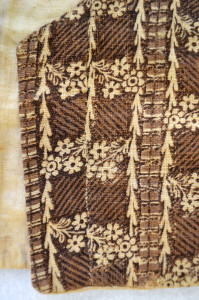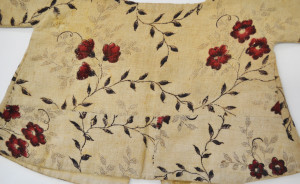As collections staff continues to unpack and rehouse artifacts after the Resource Center Renovation Project, we have been rediscovering some fascinating pieces from our costume collection. This pair of infant shirts, made with distinct printed fabrics, are said to have been worn by Mary Arnold of Newport, circa 1776. They were donated to the Society by George H. Sherman in 1923.
 Both shirts are made of plain weave fabrics, held together by tiny overcast stitches, and are fully lined with a fabric that is probably linen. Both also most likely employ variations of block printing, a common means of transferring designs to fabrics during the 18th century. Printed textiles became popular with the import of block-printed cottons from India, and European imitations of Indian block-printed designs and techniques followed in large quantity.
Both shirts are made of plain weave fabrics, held together by tiny overcast stitches, and are fully lined with a fabric that is probably linen. Both also most likely employ variations of block printing, a common means of transferring designs to fabrics during the 18th century. Printed textiles became popular with the import of block-printed cottons from India, and European imitations of Indian block-printed designs and techniques followed in large quantity.
Upon closer examination, both shirts exhibit interesting methods of construction; the “pieced” nature of each garment, particularly seen where patterns do not align (see details), suggests that stray scraps of fabric were used, perhaps from an older garment that had fallen into disrepair. This was a common practice, as textiles were some of the most valuable items purchased in an 18th century household.
Eighteenth-century babies often wore shirts with an open front, which were folded across and held in place by a petticoat worn over it. A longer dress, or “bed gown,” was worn over the petticoat, and a folded cloth called a “pilcher” covered the diaper; caps, sometimes more than one, covered the baby’s head. Babies and young children also wore support garments such as stays over their clothing as it was believed to have positive healthful effects.
Mary Arnold was the daughter of Thomas, a notable Newport silversmith and member of Trinity Church. She was born on 2 March 1776, just prior to the British occupation of Newport, and died at the age of 78 on 13 June 1853. Interestingly, a “George Sherman” also erected Mary’s gravestone in the Common Burying Ground. We are unsure if this is the same George H. Sherman who donated the shirts, or how the Sherman family may be connected to the Arnolds, but we are working to uncover details through genealogical research.
